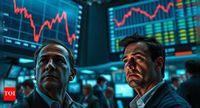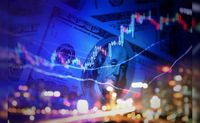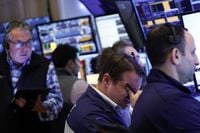Wall Street stock indices plunged on April 3, 2025, as fears of a looming trade war intensified following President Donald Trump’s sweeping tariffs on imports. The S&P 500 suffered its largest single-day percentage loss since June 2020, reflecting widespread panic among investors.
On that fateful day, a staggering $2.4 trillion in stock market value evaporated from S&P 500 companies, with the index dropping 274.45 points, or 4.84%, to close at 5,396.52. The Dow Jones Industrial Average was not far behind, plummeting 1,679.39 points, or 3.98%, to finish at 40,545.93. Meanwhile, the Nasdaq Composite dropped a significant 1,050.44 points, or 5.97%, ending at 16,550.61.
Trump's announcement of a minimum 10% tariff on most US imports, along with steeper levies on countries like China and those in the European Union, sent shockwaves through the financial markets. Investors reacted by selling off stocks across virtually all sectors, with only consumer staples remaining in positive territory.
“Clearly what was announced was close to the worst-case scenario and markets were not prepared for that and are reacting accordingly,” said Angelo Kourkafas, a senior investment strategist at Edward Jones. The tariffs have raised fears of rising inflation and slowing economic growth, with economists warning that they could reduce US economic growth by as much as 2 percentage points this year and push inflation close to 5%.
As the morning unfolded, the market sell-off intensified, with the Russell 2000 index of smaller companies dropping 6.6%, marking its worst one-day decline since the onset of the pandemic. This index is often seen as a barometer for the health of the domestic economy, and its decline underscores concerns about the impact of tariffs on small-cap stocks.
Among the hardest-hit companies, tech giants bore the brunt of the market's downturn. Apple, which relies heavily on Chinese manufacturing, saw its stock sink 9.2%, marking its worst one-day performance in five years. Other major players like Amazon dropped 9%, Nvidia slumped 7.8%, and Microsoft fell 1.28%. Retailers were also hit hard, with Nike’s stock plunging 14.4% and Ralph Lauren declining 16.3%.
Even the energy sector was not spared, as crude oil prices fell sharply—West Texas Intermediate futures plunged over 7% to trade below $67 a barrel. The energy index sank 7.5%, driven down by fears surrounding the tariffs and OPEC’s plans to increase production.
“There are still a lot more questions than answers out here,” remarked Steven DeSanctis, a small and mid-cap strategist at Jefferies Financial Group. The uncertainty surrounding the tariffs has left investors scrambling for safety, with many turning to bonds as a refuge. The yield on the benchmark 10-year US Treasury note fell below 4% for the first time since October 2024, reflecting growing concerns about the economy's future.
Internationally, markets mirrored the US decline, with major stock indexes in Europe and Asia also suffering sharp losses. France's CAC 40 dropped 3.3%, Germany's DAX lost 3%, and Japan’s Nikkei 225 fell 2.8%. The global reaction highlights the interconnectedness of the world economy and the potential ramifications of the US's tariff strategy.
In a bid to counterbalance the negative sentiment, some companies managed to post gains. Lamb Weston, for instance, advanced 10% after reporting better-than-expected quarterly results. Additionally, AstraZeneca gained 2.3% following FDA approval for one of its drugs, showcasing that not all sectors are equally affected by the tumultuous market conditions.
As the day progressed, the sell-off showed no signs of abating. The Dow Jones Industrial Average was down 1,456.07 points, or 3.45%, by mid-afternoon, while the Nasdaq Composite had widened its loss to 5.7%. The S&P 500 was also down 243.60 points, or 4.3%. Analysts noted that the tariffs have created a ripple effect throughout the economy, impacting consumer spending and business activity.
In light of the ongoing turmoil, traders are ramping up expectations for the Federal Reserve to cut interest rates. “The Fed does have considerable firepower to help the market,” stated George Bory, chief investment strategist for the fixed income team at Allspring Global Investments. “The market is now pricing in more rate cuts, and perhaps sooner,” he added, suggesting that an easing in June now seemed guaranteed, with a potential cut in May also on the table.
As the dust settles from this dramatic market upheaval, analysts are left grappling with the implications of Trump's tariff policies. With China and the European Union vowing retaliation, the specter of a trade war looms large, raising concerns about the future of global trade and economic stability. The coming weeks will be critical, as businesses and investors alike seek to navigate the uncertain waters ahead.
The volatility index, known as Wall Street’s fear gauge, closed above 30 points for the first time since August, signaling that investors should brace for continued turbulence in the markets. With so many factors at play, one thing is clear: the economic landscape is shifting, and the ramifications of these tariffs will be felt far and wide.








